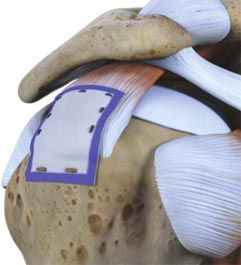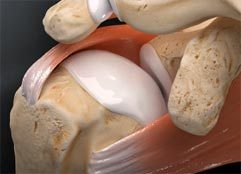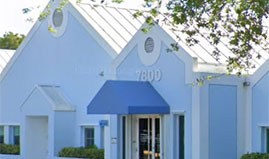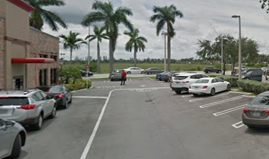Shoulder Rotator Cuff Tear
A rotator cuff tear is a common cause of shoulder pain and disability among adults. Normally there are 4 rotator cuff tendons that form a covering over the top of the shoulder. These tendons allow the shoulder to move and rotate. Most tears occur in the supraspinatus tendon, but other parts of the rotator cuff may be involved. Overuse is the most common cause of tears, however a fall or sudden injury can also cause a tear.
Pain often develops slowly over a period of time and may be worse at night-time or with overhead activities. An injury may cause acute pain. Pain may radiate down the arm towards the elbow and up towards the neck.
Your doctor will perform a comprehensive physical examination. Additional tests may be performed to rule our other possible injuries. These tests may include x-rays, bone scanning, ultrasound, and magnetic resonance imaging (MRI).
Your doctor may recommend a brief period of anti-inflammatory medication and activity modification. A course of rehabilitation may also be helpful. Injection of a corticosteroid with a local anesthetic may alleviate the symptoms. Anti-inflammatory medication should be used cautiously as these medications may have harmful secondary side-effects to blood pressure, the heart, and the kidneys. Surgery may also be an option.
Forty percent of patient treated without surgery develop enlargement of the rotator cuff tear over a 5-year period of time. However, 20% of those will have no symptoms. Therefore, less than half of patients with tears will have enlargement, but 80% of patients whose tears enlarge will develop symptoms. Small partial-thickness tears may heal without surgery.
Satisfaction rates are over 80-95% with improved range of motion and strength. Approximately 6-30% may develop a re-tear of the repair, however many of these remain asymptomatic. Outcomes are improved with earlier repair, smaller tears, patient age, and patient compliance after surgery.
Surgery is recommended when non-surgical treatments have been tried. This technique uses multiple small incisions (portals) and arthroscopic technology to visualize and repair the rotator cuff. An all-arthroscopic repair is usually an outpatient procedure, however some patients may elect to stay overnight. The tendons are repaired back to their normal bone attachments usually with suture anchors. The results of arthroscopic minimally invasive surgery are comparable, if not better than to those for mini-open repair and open repair. Rehabilitation after surgery is extremely important to regain function and strength.
- Falls, sudden pulls, or other injuries.
- Repetitive over-use of shoulder.
- A bone spur or a tight space for the tendon.
- Most patients are over the age of 40.
- Up to 30% can be younger.
- Night-time pain.
- Overhead activity pain.
- Pain at front or side of shoulder.
- Pain may radiate towards elbow or neck.
- Clicking, crunching, popping.
- By careful examination of the shoulder.
- By other diagnostic tests, such as ultrasound or MRI scan.
- Physical therapy.
- Activity modification.
- Anti-inflammatories (Motrin, Aleve) or Tylenol.
- In some cases, the pain improves with time.
- Some tears may become larger with time.
- Some small tears may heal.
- Larger tears may lead to shoulder joint arthritis.
- Some people will eventually improve.
- The tendon may retract and the muscle may atrophy
- Tears may not be repairable if too much time has elapsed.
- Either open or using arthroscopic techniques
- A camera is inserted into the shoulder and the surgeon visualizes the shoulder through a video monitor.
- A minimally-invasive surgical technique that avoids significant soft-tissue injury.
A less invasive procedure with the benefits:
- Less surgical dissection, less surgical pain, faster recovery rates.
- Better visualization of the shoulder anatomy.
- The success rate is anywhere from 60-100%.
- Several important factors influence outcome such as: age, diabetes and other medical problems, smoking, size of the tear, how long ago the tear occurred, and patient compliance with the instructions after surgery.
- The tendon can be repaired using suture anchors allowing the tendon to be sutured back to the bone.
- Anchors can be absorbable or non-absorbable, like metal.
- In the event of a massive rotator cuff tear that is not repairable, your surgeon may decide to place a graft of either allograft (cadaver) or autograft (your own) tissue.
- The graft may be sutured on top of the repaired tendon to augment the repair and provide additional strength.
- The graft may be sutured to the end of the retracted tendon and then to the bone to act as a bridge. This restores the rotator cuff muscle attachment back to the bone – known as interpositional grafting.
- If your tear is large, severely retracted, ask your physician if you are a candidate for this surgery.
- Hommen performs this surgical procedure.

- Indicated for younger patients with a massive and retracted rotator cuff tear with significant muscle atrophy that is deemed not repairable.
- Indicated for patients who are not ideal candidates for a shoulder replacement surgery with a hemiarthroplasty or reverse shoulder replacement implants.
- Involves the use of allograft or autograft tissue sutured from the humeral tuberosity rotator cuff attachment site to the superior glenoid rim.
- Acts as an internal humeral head depressor, thereby stabilizing the humeral head within the socket and preventing anterior or superior shoulder escape.
- To see if you are a candidate for a superior capsule reconstruction, ask your physician.
- Hommen performs this surgical procedure.


- If you continue to have pain despite therapy and medications.
- If you wish to restore tendon function and relieve pain.
- Earlier repairs have better outcomes than delayed repairs.
- Chronic tears with atrophy of the muscle belly might preclude rotator cuff repair surgery.
- Success is higher in patients under the age of 70. However, age itself is not the limiting factor.
- A careful pre-operative assessment from your medical internist can determine if you are a candidate for surgery.
- Arthroscopies are performed under general anesthesia.
- The anesthesiologist may also perform a nerve block.
- A nerve block helps to reduce the amount of general anesthesia delivered as well as make you comfortable after surgery.
- You may take your regularly scheduled medications for blood pressure and diabetes.
- Certain medications must be stopped well before surgery (such as blood thinners). A complete list of these medications will be given to you by our office staff.
- Do not eat or drink after midnight before your surgery.
- You will be contacted by the hospital or surgical center the day before surgery.
- You will be notified: when to arrive for your surgery, when you should not eat, and what medications you may continue to take. They will be helpful in answering questions you may have concerning medications, transportation, and other concerns.
- The majority of arthroscopic cases are outpatient procedures and patients are allowed to go home the same day of their procedure.
- In certain cases, patients may stay overnight for observation at the hospital and will be allowed to go home the following morning after surgery.
- Patients who have a nerve block, will have prolonged anesthesia to the shoulder and arm and may go home with the arm still “numb”.
- Therefore, be careful to avoid any pressure or injury to the shoulder and arm as you will not feel the pain until the block has worn off.
- Most nerve blocks will wear off 12 hours after surgery, but some blocks may be shorter while others may last 24 hours.
- Be sure to take your pain medications prescribed to you once you get home. Do not wait to take the medications until the nerve block wears off.
- You should arrange transportation with family, friends, or other means for after surgery.
- Do not drive home after having been administered anesthetics.
- Driving is NOT permitted for 2-6 weeks after surgery depending on the type of procedure performed.
- As with any surgery, there will be surgical pain. The benefits of minimally-invasive arthroscopic surgery include the limited amount of surgical dissection and faster recovery time.
- You will be prescribed narcotic medication to go home with.
- Do NOT make important decisions while taking narcotic medications.
- Sleeping in a seated position such as a reclining chair or in a bed with pillows behind you may help you sleep better the first few days after surgery.
- Do not attempt to lift the arm “actively” by yourself until directed. A qualified therapist will move the arm for you.
- Do NOT remove the sling. Remove the sling only for hygiene.
- The tendon is repaired to bone with sutures and will take about 6 weeks to heal onto the bone and even longer for a firm repair. Early active activity may cause failure of your repair.
- Do NOT make important decisions immediately after surgery or while on narcotic medications.
- Do not bathe or submerge the shoulder in a pool until you have been cleared to do so.
- You may shower after 72 hours if the incisions are dry.
- You may remove the shoulder dressings after 72 hours.
- Please do NOT remove the white sticky “steri-strips” or “butterfly stitches”.
- Towel-dry the incision after showering.
- Do not take a shower if you notice any drainage from the incision sites.
- You will be prescribed a narcotic for pain relief after surgery.
- You are recommended to continue the medications for at least 48 to 72 hours as directed and then wean the medications when you are able. This avoids unnecessary build-up of pain.
- You may switch to other medications such as Aleve, Motrin, and/or Tylenol if you are able to take these medications.
Weaning narcotics is best done by alternating Tylenol or anti-inflammatory medications like Aleve or Motrin in place of a regularly scheduled narcotic pill at every other scheduled narcotic dose.
- Narcotics are eventually discontinued altogether.
- Narcotics can make you constipated, nauseous, and can affect your ability to make decisions. They can also be addictive if used inappropriately.
- The shoulder MUST be maintained in a sling for 6 weeks (day and night time) except for showers, bathing, and therapy.
- Non-compliance with immobilization can cause failure of the repair.
- Bring a loose-fitting shirt (button-down or over-sized large T-shirt).
- The arm is placed in the sling. The shirt is placed over the arm and sling.
- Therapy begins according to a strict therapy schedule usually 2-5 days after surgery depending on the strength and size of repair.
- Physical therapy continues over a 16-week period progressing from full immobilization to full active return to activities.
- It may take approximately 4-6 months before returning to full overhead activities, golf and other activities.
- Return to full activity depends on the size of the tear, activity requirements, and the repair strength.
- Each patient has an individually designed rehab program.
- Therapy is performed with a licensed therapist usually at approved outpatient therapy centers.
- Hommen will tailor a therapy protocol according to your shoulder needs that the therapist will follow.
Usually sometime after 4-6 weeks after surgery.













